seat control JEEP RENEGADE 2017 1.G User Guide
[x] Cancel search | Manufacturer: JEEP, Model Year: 2017, Model line: RENEGADE, Model: JEEP RENEGADE 2017 1.GPages: 516, PDF Size: 5.73 MB
Page 219 of 516
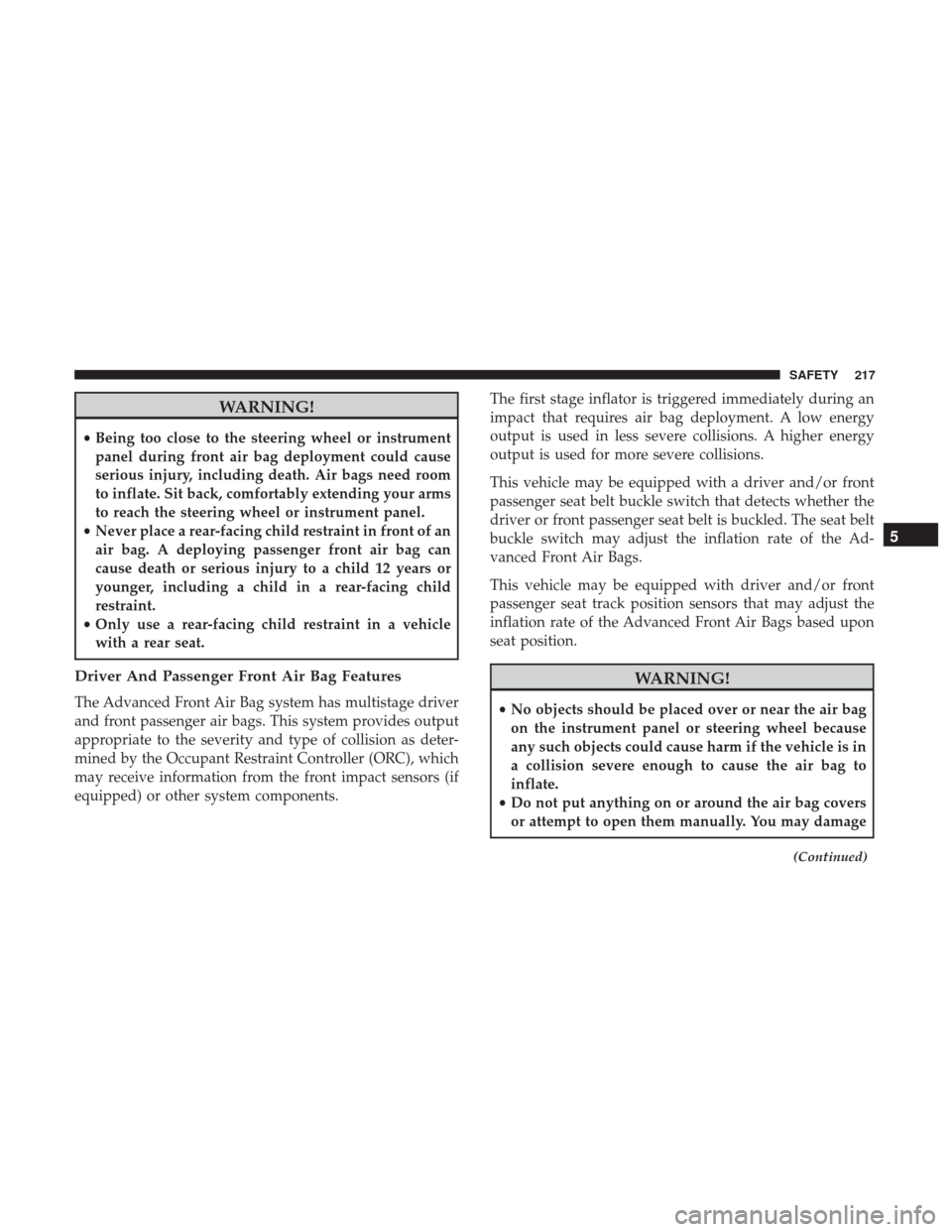
WARNING!
•Being too close to the steering wheel or instrument
panel during front air bag deployment could cause
serious injury, including death. Air bags need room
to inflate. Sit back, comfortably extending your arms
to reach the steering wheel or instrument panel.
• Never place a rear-facing child restraint in front of an
air bag. A deploying passenger front air bag can
cause death or serious injury to a child 12 years or
younger, including a child in a rear-facing child
restraint.
• Only use a rear-facing child restraint in a vehicle
with a rear seat.
Driver And Passenger Front Air Bag Features
The Advanced Front Air Bag system has multistage driver
and front passenger air bags. This system provides output
appropriate to the severity and type of collision as deter-
mined by the Occupant Restraint Controller (ORC), which
may receive information from the front impact sensors (if
equipped) or other system components. The first stage inflator is triggered immediately during an
impact that requires air bag deployment. A low energy
output is used in less severe collisions. A higher energy
output is used for more severe collisions.
This vehicle may be equipped with a driver and/or front
passenger seat belt buckle switch that detects whether the
driver or front passenger seat belt is buckled. The seat belt
buckle switch may adjust the inflation rate of the Ad-
vanced Front Air Bags.
This vehicle may be equipped with driver and/or front
passenger seat track position sensors that may adjust the
inflation rate of the Advanced Front Air Bags based upon
seat position.
WARNING!
•
No objects should be placed over or near the air bag
on the instrument panel or steering wheel because
any such objects could cause harm if the vehicle is in
a collision severe enough to cause the air bag to
inflate.
• Do not put anything on or around the air bag covers
or attempt to open them manually. You may damage
(Continued)
5
SAFETY 217
Page 223 of 516
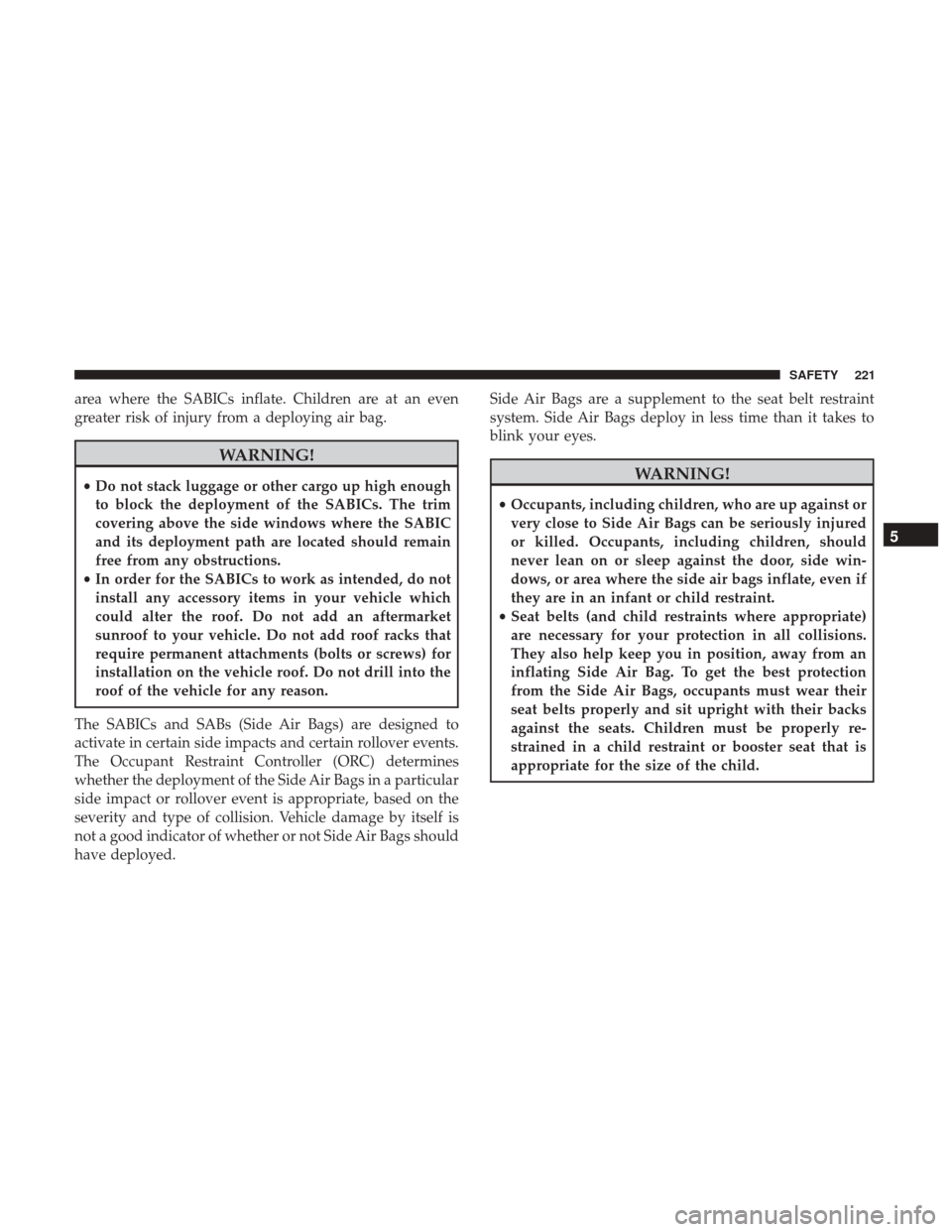
area where the SABICs inflate. Children are at an even
greater risk of injury from a deploying air bag.
WARNING!
•Do not stack luggage or other cargo up high enough
to block the deployment of the SABICs. The trim
covering above the side windows where the SABIC
and its deployment path are located should remain
free from any obstructions.
• In order for the SABICs to work as intended, do not
install any accessory items in your vehicle which
could alter the roof. Do not add an aftermarket
sunroof to your vehicle. Do not add roof racks that
require permanent attachments (bolts or screws) for
installation on the vehicle roof. Do not drill into the
roof of the vehicle for any reason.
The SABICs and SABs (Side Air Bags) are designed to
activate in certain side impacts and certain rollover events.
The Occupant Restraint Controller (ORC) determines
whether the deployment of the Side Air Bags in a particular
side impact or rollover event is appropriate, based on the
severity and type of collision. Vehicle damage by itself is
not a good indicator of whether or not Side Air Bags should
have deployed. Side Air Bags are a supplement to the seat belt restraint
system. Side Air Bags deploy in less time than it takes to
blink your eyes.WARNING!
•
Occupants, including children, who are up against or
very close to Side Air Bags can be seriously injured
or killed. Occupants, including children, should
never lean on or sleep against the door, side win-
dows, or area where the side air bags inflate, even if
they are in an infant or child restraint.
• Seat belts (and child restraints where appropriate)
are necessary for your protection in all collisions.
They also help keep you in position, away from an
inflating Side Air Bag. To get the best protection
from the Side Air Bags, occupants must wear their
seat belts properly and sit upright with their backs
against the seats. Children must be properly re-
strained in a child restraint or booster seat that is
appropriate for the size of the child.
5
SAFETY 221
Page 225 of 516
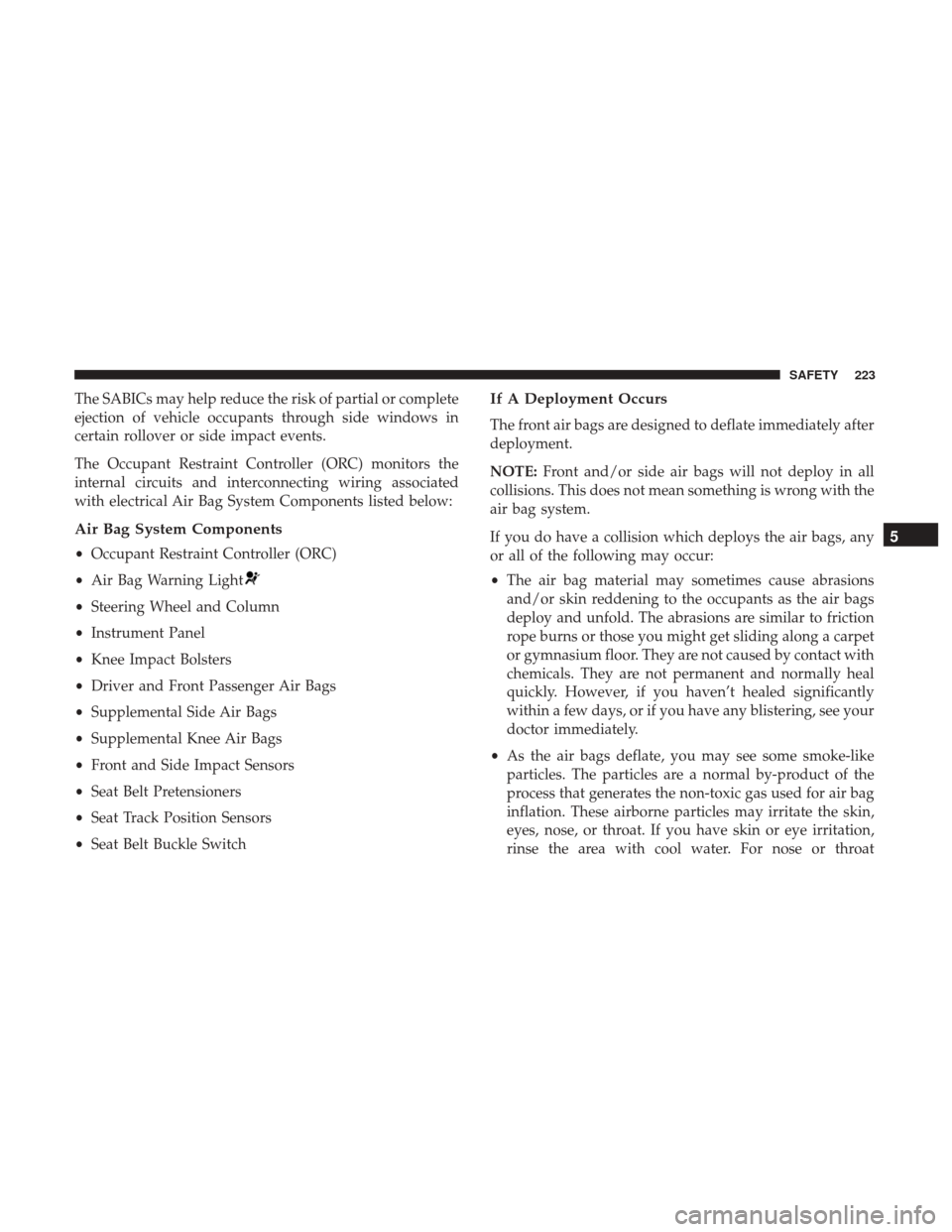
The SABICs may help reduce the risk of partial or complete
ejection of vehicle occupants through side windows in
certain rollover or side impact events.
The Occupant Restraint Controller (ORC) monitors the
internal circuits and interconnecting wiring associated
with electrical Air Bag System Components listed below:
Air Bag System Components
•Occupant Restraint Controller (ORC)
• Air Bag Warning Light
•Steering Wheel and Column
• Instrument Panel
• Knee Impact Bolsters
• Driver and Front Passenger Air Bags
• Supplemental Side Air Bags
• Supplemental Knee Air Bags
• Front and Side Impact Sensors
• Seat Belt Pretensioners
• Seat Track Position Sensors
• Seat Belt Buckle Switch
If A Deployment Occurs
The front air bags are designed to deflate immediately after
deployment.
NOTE: Front and/or side air bags will not deploy in all
collisions. This does not mean something is wrong with the
air bag system.
If you do have a collision which deploys the air bags, any
or all of the following may occur:
• The air bag material may sometimes cause abrasions
and/or skin reddening to the occupants as the air bags
deploy and unfold. The abrasions are similar to friction
rope burns or those you might get sliding along a carpet
or gymnasium floor. They are not caused by contact with
chemicals. They are not permanent and normally heal
quickly. However, if you haven’t healed significantly
within a few days, or if you have any blistering, see your
doctor immediately.
• As the air bags deflate, you may see some smoke-like
particles. The particles are a normal by-product of the
process that generates the non-toxic gas used for air bag
inflation. These airborne particles may irritate the skin,
eyes, nose, or throat. If you have skin or eye irritation,
rinse the area with cool water. For nose or throat
5
SAFETY 223
Page 226 of 516
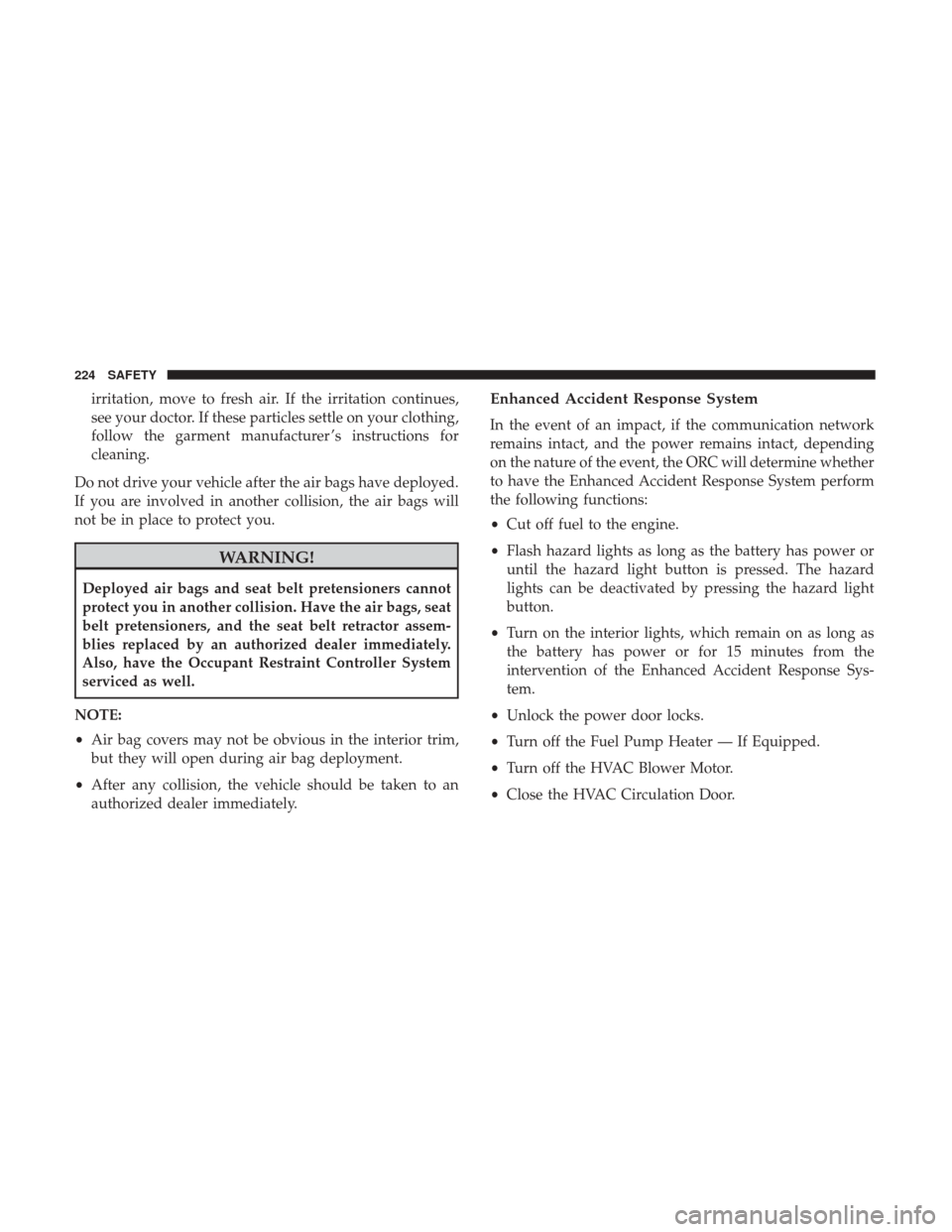
irritation, move to fresh air. If the irritation continues,
see your doctor. If these particles settle on your clothing,
follow the garment manufacturer ’s instructions for
cleaning.
Do not drive your vehicle after the air bags have deployed.
If you are involved in another collision, the air bags will
not be in place to protect you.
WARNING!
Deployed air bags and seat belt pretensioners cannot
protect you in another collision. Have the air bags, seat
belt pretensioners, and the seat belt retractor assem-
blies replaced by an authorized dealer immediately.
Also, have the Occupant Restraint Controller System
serviced as well.
NOTE:
• Air bag covers may not be obvious in the interior trim,
but they will open during air bag deployment.
• After any collision, the vehicle should be taken to an
authorized dealer immediately.
Enhanced Accident Response System
In the event of an impact, if the communication network
remains intact, and the power remains intact, depending
on the nature of the event, the ORC will determine whether
to have the Enhanced Accident Response System perform
the following functions:
• Cut off fuel to the engine.
• Flash hazard lights as long as the battery has power or
until the hazard light button is pressed. The hazard
lights can be deactivated by pressing the hazard light
button.
• Turn on the interior lights, which remain on as long as
the battery has power or for 15 minutes from the
intervention of the Enhanced Accident Response Sys-
tem.
• Unlock the power door locks.
• Turn off the Fuel Pump Heater — If Equipped.
• Turn off the HVAC Blower Motor.
• Close the HVAC Circulation Door.
224 SAFETY
Page 246 of 516
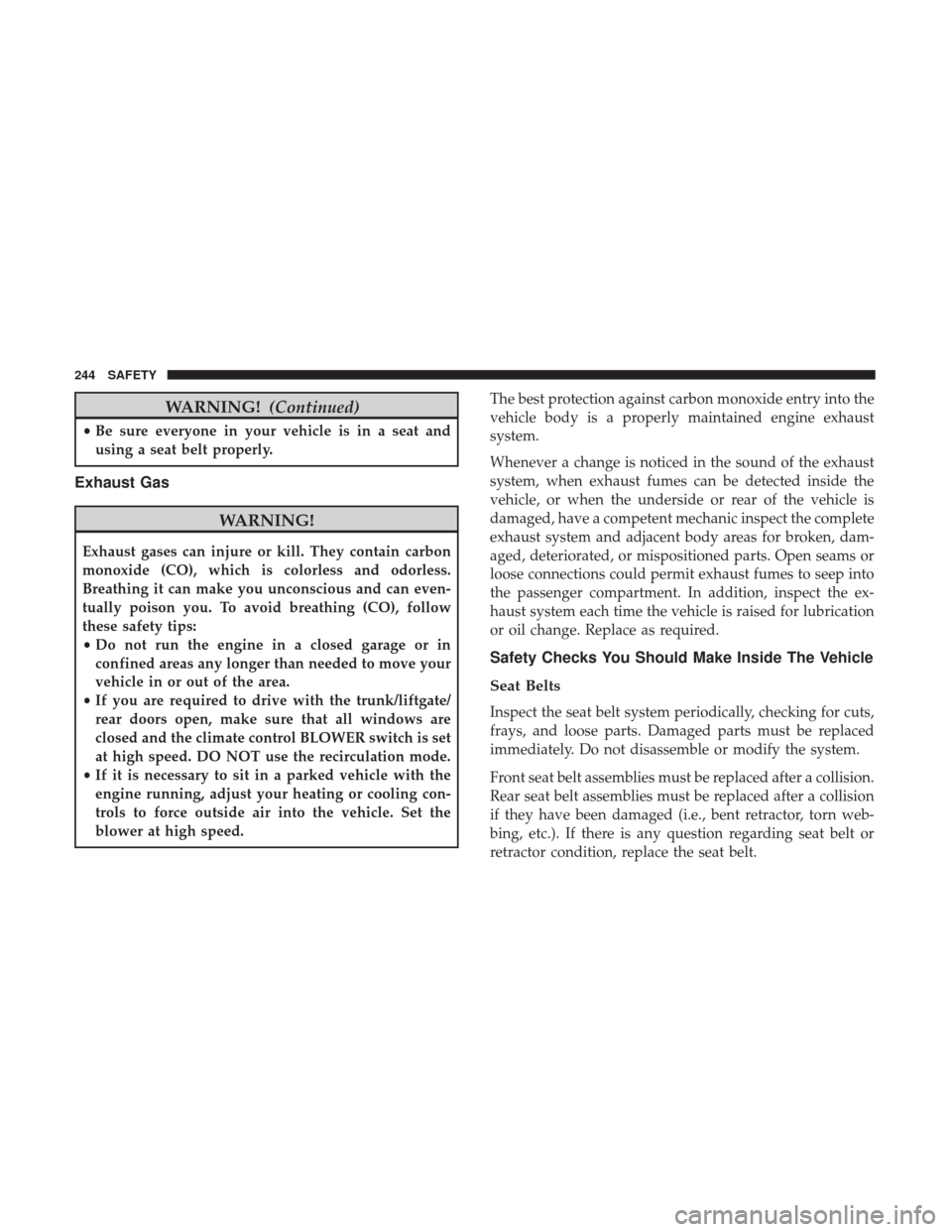
WARNING!(Continued)
•Be sure everyone in your vehicle is in a seat and
using a seat belt properly.
Exhaust Gas
WARNING!
Exhaust gases can injure or kill. They contain carbon
monoxide (CO), which is colorless and odorless.
Breathing it can make you unconscious and can even-
tually poison you. To avoid breathing (CO), follow
these safety tips:
• Do not run the engine in a closed garage or in
confined areas any longer than needed to move your
vehicle in or out of the area.
• If you are required to drive with the trunk/liftgate/
rear doors open, make sure that all windows are
closed and the climate control BLOWER switch is set
at high speed. DO NOT use the recirculation mode.
• If it is necessary to sit in a parked vehicle with the
engine running, adjust your heating or cooling con-
trols to force outside air into the vehicle. Set the
blower at high speed. The best protection against carbon monoxide entry into the
vehicle body is a properly maintained engine exhaust
system.
Whenever a change is noticed in the sound of the exhaust
system, when exhaust fumes can be detected inside the
vehicle, or when the underside or rear of the vehicle is
damaged, have a competent mechanic inspect the complete
exhaust system and adjacent body areas for broken, dam-
aged, deteriorated, or mispositioned parts. Open seams or
loose connections could permit exhaust fumes to seep into
the passenger compartment. In addition, inspect the ex-
haust system each time the vehicle is raised for lubrication
or oil change. Replace as required.
Safety Checks You Should Make Inside The Vehicle
Seat Belts
Inspect the seat belt system periodically, checking for cuts,
frays, and loose parts. Damaged parts must be replaced
immediately. Do not disassemble or modify the system.
Front seat belt assemblies must be replaced after a collision.
Rear seat belt assemblies must be replaced after a collision
if they have been damaged (i.e., bent retractor, torn web-
bing, etc.). If there is any question regarding seat belt or
retractor condition, replace the seat belt.
244 SAFETY
Page 253 of 516
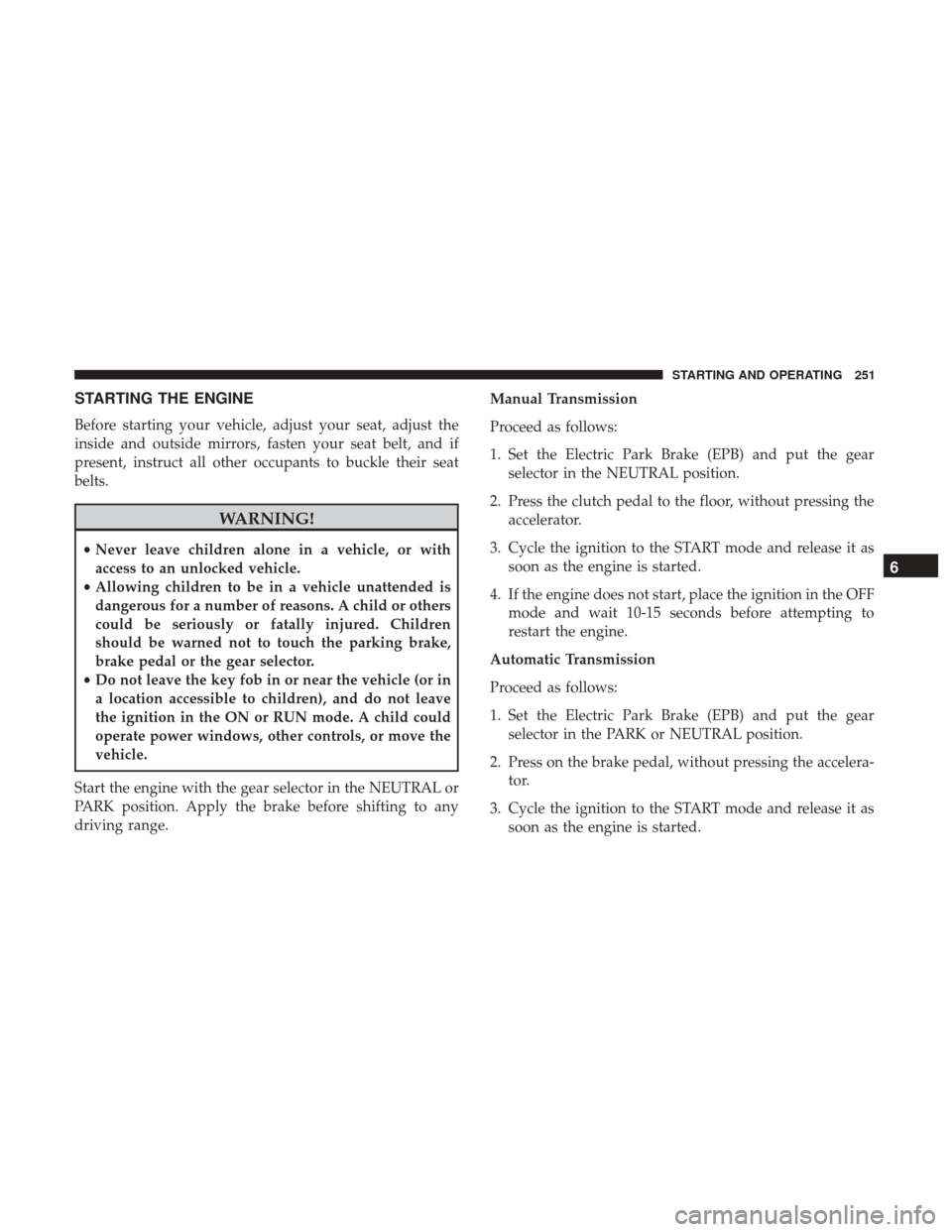
STARTING THE ENGINE
Before starting your vehicle, adjust your seat, adjust the
inside and outside mirrors, fasten your seat belt, and if
present, instruct all other occupants to buckle their seat
belts.
WARNING!
•Never leave children alone in a vehicle, or with
access to an unlocked vehicle.
• Allowing children to be in a vehicle unattended is
dangerous for a number of reasons. A child or others
could be seriously or fatally injured. Children
should be warned not to touch the parking brake,
brake pedal or the gear selector.
• Do not leave the key fob in or near the vehicle (or in
a location accessible to children), and do not leave
the ignition in the ON or RUN mode. A child could
operate power windows, other controls, or move the
vehicle.
Start the engine with the gear selector in the NEUTRAL or
PARK position. Apply the brake before shifting to any
driving range. Manual Transmission
Proceed as follows:
1. Set the Electric Park Brake (EPB) and put the gear
selector in the NEUTRAL position.
2. Press the clutch pedal to the floor, without pressing the accelerator.
3. Cycle the ignition to the START mode and release it as soon as the engine is started.
4. If the engine does not start, place the ignition in the OFF mode and wait 10-15 seconds before attempting to
restart the engine.
Automatic Transmission
Proceed as follows:
1. Set the Electric Park Brake (EPB) and put the gear selector in the PARK or NEUTRAL position.
2. Press on the brake pedal, without pressing the accelera- tor.
3. Cycle the ignition to the START mode and release it as soon as the engine is started.
6
STARTING AND OPERATING 251
Page 269 of 516

WARNING!(Continued)
turn the ignition OFF. When the ignition is in the
OFF mode, the transmission is locked in PARK,
securing the vehicle against unwanted movement.
• When leaving the vehicle, always make sure the
ignition is in the OFF mode, remove the key fob from
the vehicle, and lock the vehicle.
• Never leave children alone in a vehicle, or with
access to an unlocked vehicle. Allowing children to
be in a vehicle unattended is dangerous for a number
of reasons. A child or others could be seriously or
fatally injured. Children should be warned not to
touch the parking brake, brake pedal or the trans-
mission gear selector.
• Do not leave the key fob in or near the vehicle (or in
a location accessible to children), and do not leave
the ignition in the ON or RUN mode. A child could
operate power windows, other controls, or move the
vehicle.
CAUTION!
• Before moving the transmission gear selector out of
PARK, you must turn the ignition to the ON/RUN
mode, and also press the brake pedal. Otherwise,
damage to the gear selector could result.
• DO NOT race the engine when shifting from PARK
or NEUTRAL into another gear range, as this can
damage the drivetrain.
The following indicators should be used to ensure that you
have properly engaged the transmission into the PARK
position:
• When shifting into PARK, press the lock button on the
gear selector, and firmly move the gear selector all the
way forward until it stops and is fully seated.
• Look at the transmission gear position display and
verify that it indicates the PARK position (P), and is not
blinking.
• With the brake pedal released, verify that the gear
selector will not move out of PARK.
6
STARTING AND OPERATING 267
Page 351 of 516
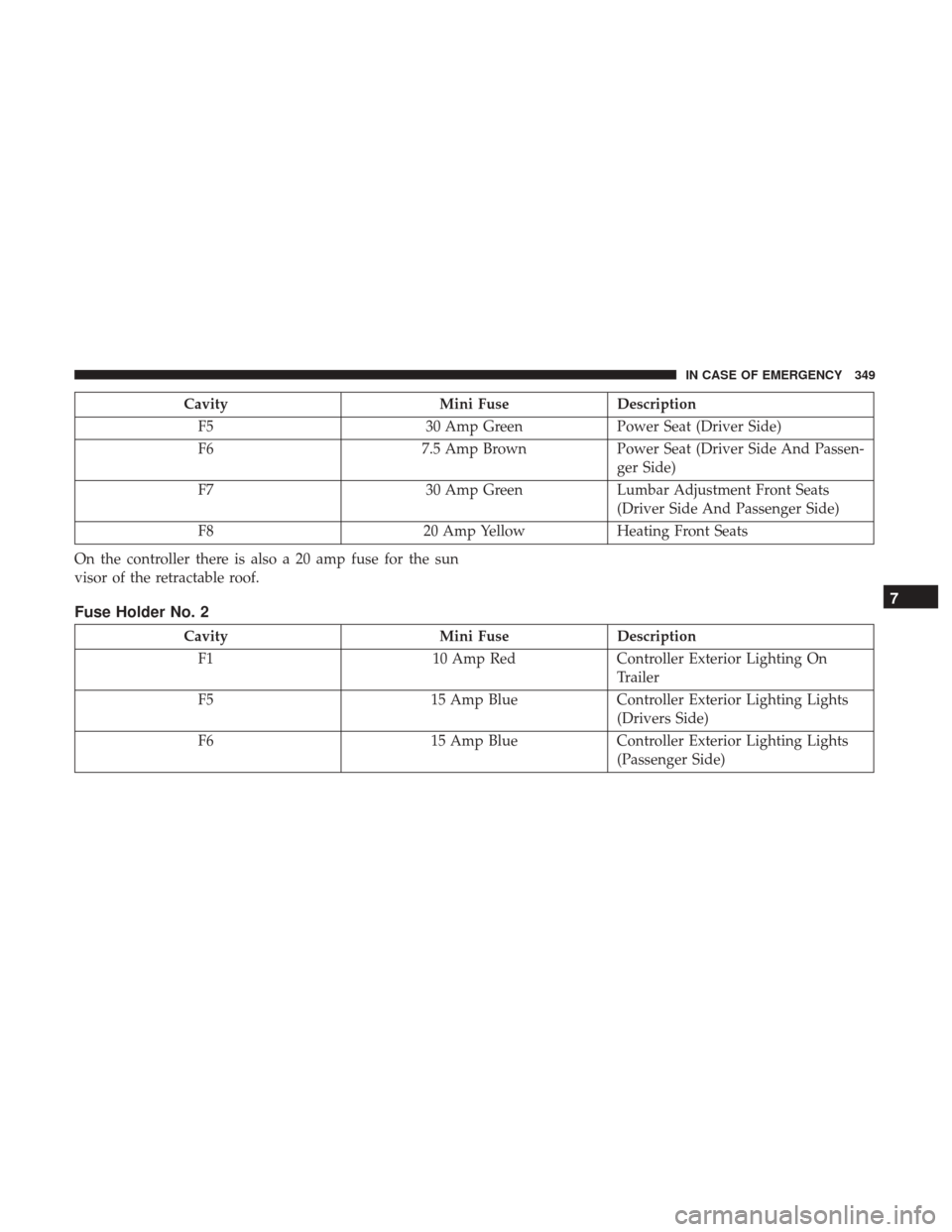
CavityMini FuseDescription
F5 30 Amp GreenPower Seat (Driver Side)
F6 7.5 Amp BrownPower Seat (Driver Side And Passen-
ger Side)
F7 30 Amp GreenLumbar Adjustment Front Seats
(Driver Side And Passenger Side)
F8 20 Amp YellowHeating Front Seats
On the controller there is also a 20 amp fuse for the sun
visor of the retractable roof.
Fuse Holder No. 2
Cavity Mini FuseDescription
F1 10 Amp RedController Exterior Lighting On
Trailer
F5 15 Amp BlueController Exterior Lighting Lights
(Drivers Side)
F6 15 Amp BlueController Exterior Lighting Lights
(Passenger Side)
7
IN CASE OF EMERGENCY 349
Page 503 of 516
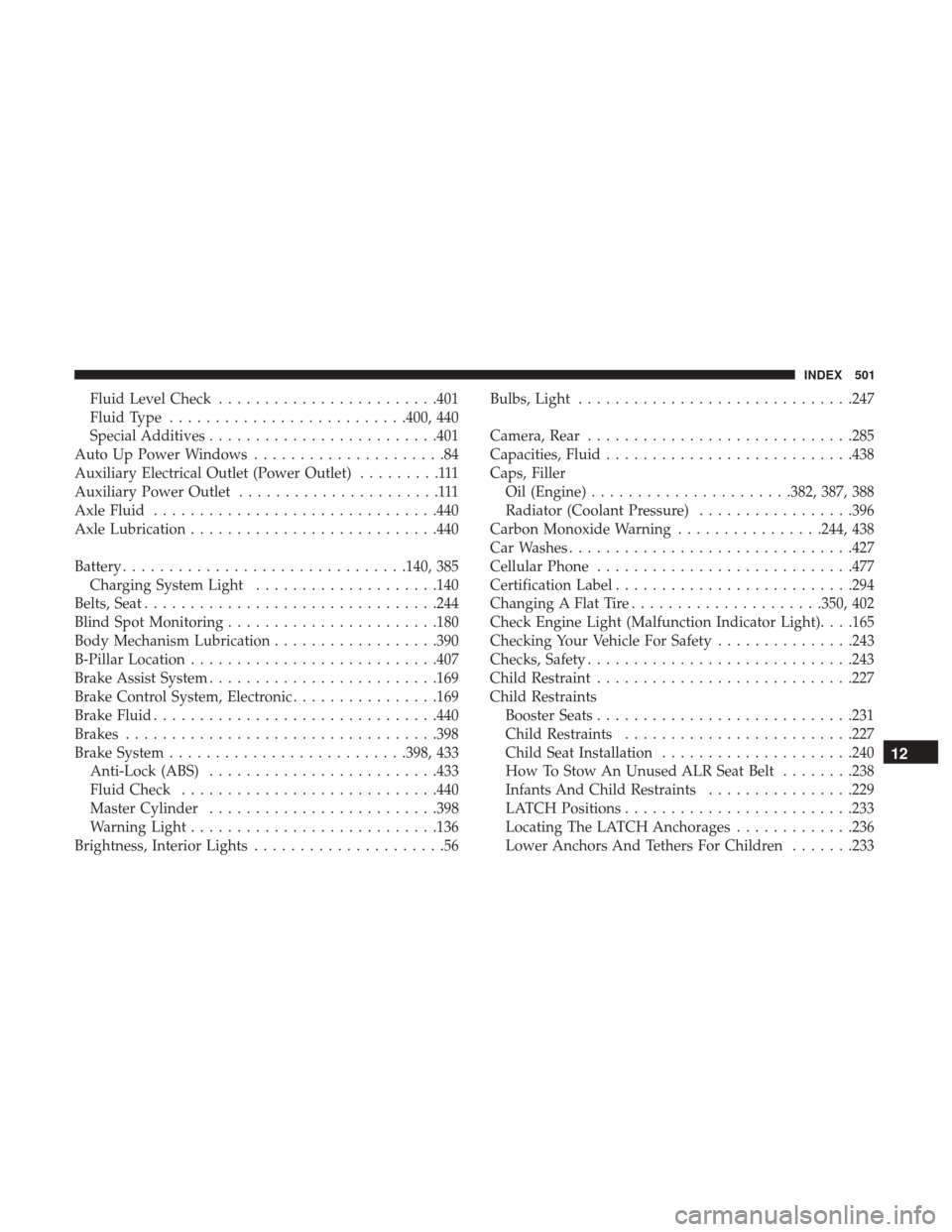
Fluid Level Check....................... .401
Fluid Type ......................... .400, 440
Special Additives ........................ .401
Auto Up Power Windows .....................84
Auxiliary Electrical Outlet (Power Outlet) .........111
Auxiliary Power Outlet ......................111
Axle Fluid .............................. .440
Axle Lubrication .......................... .440
Battery .............................. .140, 385
Charging System Light ....................140
Belts, Seat ............................... .244
Blind Spot Monitoring ...................... .180
Body Mechanism Lubrication ..................390
B-Pillar Location .......................... .407
Brake Assist System ........................ .169
Brake Control System, Electronic ................169
Brake Fluid .............................. .440
Brakes ................................. .398
Brake System ......................... .398, 433
Anti-Lock (ABS) ........................ .433
Fluid Check ........................... .440
Master Cylinder ........................ .398
Warning Light .......................... .136
Brightness, Interior Lights .....................56 Bulbs, Light
............................. .247
Camera, Rear ............................ .285
Capacities, Fluid .......................... .438
Caps, Filler Oil (Engine) ..................... .382, 387, 388
Radiator (Coolant Pressure) .................396
Carbon Monoxide Warning ................244, 438
Car Washes .............................. .427
Cellular Phone ........................... .477
Certification Label ......................... .294
Changing A Flat Tire .....................350, 402
Check Engine Light (Malfunction Indicator Light). . . .165
Checking Your Vehicle For Safety ...............243
Checks,
Safety............................ .243
Child Restraint ........................... .227
Child Restraints Booster Seats ........................... .231
Child Restraints ........................ .227
Child Seat Installation .....................240
How To Stow An Unused ALR Seat Belt ........238
Infants And Child Restraints ................229
LATCH Positions ........................ .233
Locating The LATCH Anchorages .............236
Lower Anchors And Tethers For Children .......233
12
INDEX 501
Page 504 of 516
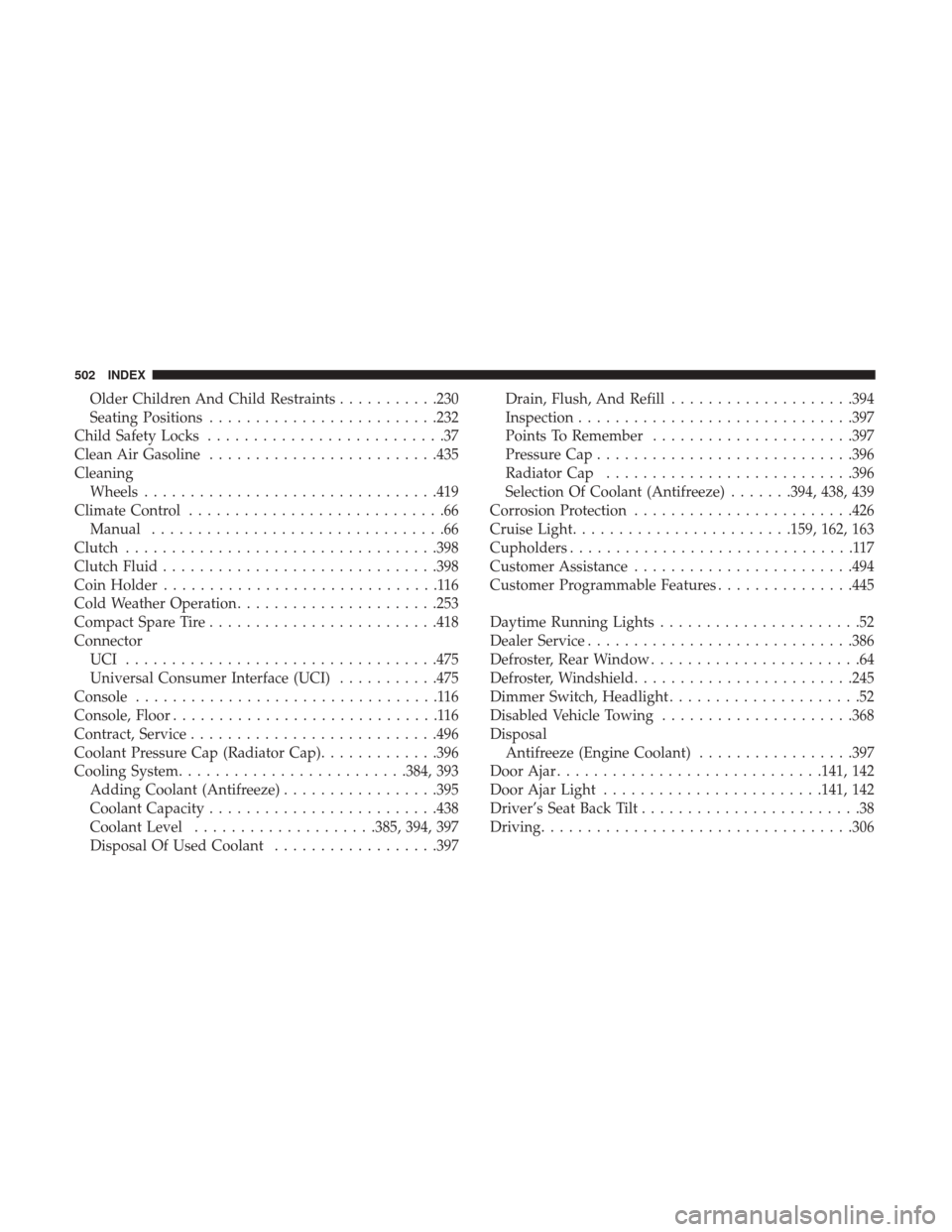
Older Children And Child Restraints...........230
Seating Positions ........................ .232
Child Safety Locks ..........................37
Clean Air Gasoline ........................ .435
Cleaning Wheels ............................... .419
Climate Control ............................66
Manual ................................66
Clutch ................................. .398
Clutch Fluid ............................. .398
Coin Holder ..............................116
Cold Weather Operation ..................... .253
Compact Spare Tire ........................ .418
Connector UCI ................................. .475
Universal Consumer Interface (UCI) ...........475
Console .................................116
Console, Floor .............................116
Contract, Service .......................... .496
Coolant Pressure Cap (Radiator Cap) .............396
Cooling System ........................ .384, 393
Adding Coolant (Antifreeze) .................395
Coolant Capacity ........................ .438
Coolant Level ....................385, 394, 397
Disposal Of Used Coolant ..................397 Drain, Flush, And Refill
....................394
Inspection ............................. .397
Points To Remember ..................... .397
Pressure Cap ........................... .396
Radiator Cap .......................... .396
Selection Of Coolant (Antifreeze) .......394, 438, 439
Corrosion Protection ....................... .426
Cruise Light ....................... .159, 162, 163
Cupholders ...............................117
Customer Assistance ....................... .494
Customer Programmable Features ...............445
Daytime Running Lights ......................52
Dealer Service ............................ .386
Defroster, Rear Window .......................
64
Defroster, Windshield ....................... .245
Dimmer Switch, Headlight .....................52
Disabled Vehicle Towing .....................368
Disposal Antifreeze (Engine Coolant) .................397
Door Ajar ............................ .141, 142
Door Ajar Light ....................... .141, 142
Driver’s Seat Back Tilt ........................38
Driving ................................. .306
502 INDEX